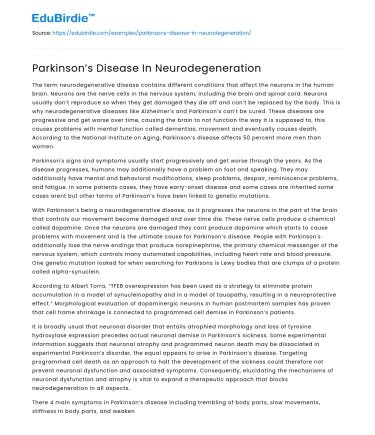The term neurodegenerative disease contains different conditions that affect the neurons in the human brain. Neurons are the nerve cells in the nervous system, including the brain and spinal cord. Neurons usually don’t reproduce so when they get damaged they die off and can’t be replaced by the body. This is why neurodegenerative diseases like Alzheimer’s and Parkinson’s can’t be cured. These diseases are progressive and get worse over time, causing the brain to not function the way it is supposed to, this causes problems with mental function called dementias, movement and eventually causes death. According to the National Institute on Aging, Parkinson’s disease affects 50 percent more men than women.
Parkinson's signs and symptoms usually start progressively and get worse through the years. As the disease progresses, humans may additionally have a problem on foot and speaking. They may additionally have mental and behavioral modifications, sleep problems, despair, reminiscence problems, and fatigue. In some patients cases, they have early-onset disease and some cases are inherited some cases arent but other forms of Parkinson’s have been linked to genetic mutations.
Save your time!
We can take care of your essay
- Proper editing and formatting
- Free revision, title page, and bibliography
- Flexible prices and money-back guarantee
With Parkinson’s being a neurodegenerative disease, as it progresses the neurons in the part of the brain that controls our movement become damaged and over time die. These nerve cells produce a chemical called dopamine. Once the neurons are damaged they cant produce dopamine which starts to cause problems with movement and is the ultimate cause for Parkinson’s disease. People with Parkinson's additionally lose the nerve endings that produce norepinephrine, the primary chemical messenger of the nervous system, which controls many automated capabilities, including heart rate and blood pressure. One genetic mutation looked for when searching for Parkisons is Lewy bodies that are clumps of a protein called alpha-synuclein.
According to Albert Torra, “TFEB overexpression has been used as a strategy to eliminate protein accumulation in a model of synucleinopathy and in a model of tauopathy, resulting in a neuroprotective effect.” Morphological evaluation of dopaminergic neurons in human postmortem samples has proven that cell frame shrinkage is connected to programmed cell demise in Parkinson’s patients.
It is broadly usual that neuronal disorder that entails atrophied morphology and loss of tyrosine hydroxylase expression precedes actual neuronal demise in Parkinson’s sickness. Some experimental information suggests that neuronal atrophy and programmed neuron death may be dissociated in experimental Parkinson’s disorder, the equal appears to arise in Parkinson’s disease. Targeting programmed cell death as an approach to halt the development of the sickness could therefore not prevent neuronal dysfunction and associated symptoms. Consequently, elucidating the mechanisms of neuronal dysfunction and atrophy is vital to expand a therapeutic approach that blocks neurodegeneration in all aspects.
There 4 main symptoms in Parkinson’s disease including trembling of body parts, slow movements, stiffness in body parts, and weaken balance. According to Nrupa Borkar “Apomorphine has a similar chemical structure as the neurotransmitter dopamine and has been used for the treatment of advanced PD patients. In PD patients, apomorphine is normally administered subcutaneously with frequent injections because of the compound’s extensive hepatic first-pass metabolism. There is, hence, a large unmet need for alternative administrative routes for apomorphine to improve patient compliance.” When apomorphine is used in Parkinson’s patients it is seen to decrease in termors which is one of the main symptoms of Parkinson’s. Termors are when a person trembles or shakes in hands, legs, head and a person’s jaws.






 Stuck on your essay?
Stuck on your essay?

